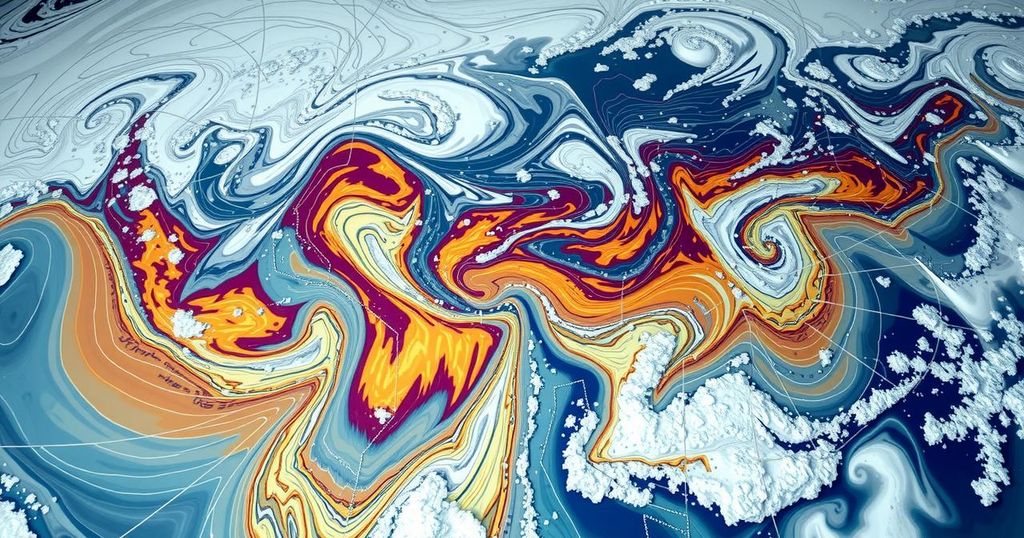Understanding the Impact of Climate Change on Extreme Weather Patterns

The article examines the connection between extreme weather events and climate change, noting significant weather incidents in 2025 and advancements in climate science that allow for clearer attribution of these events to human-caused climate change. It discusses the differences between climate and weather, the observable effects of rising global temperatures, and methods researchers use to discern the impact of fossil fuel emissions on weather phenomena.
The year 2025 commenced with a series of severe weather events, including 100-mph winds in Southern California leading to catastrophic wildfires, alongside significant winter storms affecting the Mid-Atlantic and Southern states. Coupled with these events, scientists have reported that 2024 was notably the hottest year on record, primarily driven by anthropogenic climate change.
Historically, climate scientists refrained from attributing individual weather anomalies directly to climate change; however, advancements in climatological science now enable researchers to assess the relationship between climate change and various extreme weather events such as heat waves, hurricanes, and wildfires more accurately.
While not every weather variation is clearly linked to climate change, the rising global temperatures are increasingly observable within many extreme weather trends. According to Justin Mankin, a climate scientist at Dartmouth College, “The trends in climate are shaping new weather possibilities that were maybe unprecedented.”
To comprehend the relationship between climate and weather, scientists often articulate that climate denotes long-term patterns—what one prepares for—while weather signifies short-term conditions—what one faces daily. As Danielle Touma from the University of Texas, Austin, metaphorically states, “The climate is basically the clothes you have in your closet,” while the specific daily weather may compel one to select a different outfit.
The average climate of a region is typically understood as its weather patterns over a span of thirty years, highlighting that unusual weather events can play a role, but do not dominate the overall picture. Deepti Singh of Washington State University notes that certain weather variations will remain, even amid ongoing climate changes.
Human-induced climate change has resulted in a global temperature increase of approximately 1.3 degrees Celsius since the mid-19th century, coinciding with the extensive combustion of fossil fuels. Such activity leads to heat retention within the Earth’s atmosphere, progressively warming the air, oceans, and land.
Though daily weather may not always exhibit obvious changes due to this gradual temperature rise, its influence likely manifests subtly across various weather patterns day-to-day. Deepti Singh asserts, “Everything we’re experiencing, it is occurring in a different environment.”
Empirical evidence illustrates a decline in freezing days across regions such as Michigan and Ohio, which now report over a week fewer freezing days than would be expected in the absence of climate change. Furthermore, heat waves have significantly proliferated, more than tripling since the 1960s. Human-induced climate change has altered atmospheric and oceanic behaviors, culminating in previously unattainable weather phenomena, as exemplified by the 2021 heat wave in the Pacific Northwest, which was considerably exacerbated by climate change.
Scientific advancements in detection and attribution techniques have allowed researchers to evaluate how weather events would unfold without the impact of human-induced climate change. By using climate models, they can compare actual scenarios with hypothetical ones to ascertain the likelihood and intensity of weather events under normal circumstances. For instance, they calculated that Hurricane Helene’s rainfall intensity was 10% greater due to climate change, with a 40% increase in likelihood.
Mankin analogizes this methodology to clinical trials, establishing a comparative framework to analyze the effects of fossil fuel combustion much like a treatment’s efficacy in a controlled environment.
The article centers on the intricate relationship between climate change and weather phenomena, highlighting recent extreme weather events and advancements in climate science that enable better understanding of this connection. It discusses how anthropogenic climate change affects not only significant weather extremes, such as hurricanes and wildfires, but also more subtle variations in daily weather patterns. The piece incorporates insights from various climate scientists, explaining the distinction between climate and weather while emphasizing the need for refined methodologies to evaluate these changes empirically.
In summary, the interplay between climate change and weather events is becoming increasingly evident as scientific advancements allow for clearer attribution of extreme weather patterns to human activity. The rise in global temperatures, attributed to fossil fuel emissions, has reshaped both daily weather conditions and broader climatic behaviors. As researchers continue to refine their methodologies for assessing these relationships, the implications for understanding future weather trends remain critical.
Original Source: www.weku.org






